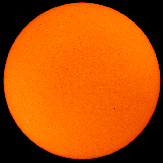During a misspent youth one of my follies was following in William Herschel's footsteps.
First, this report on prices at the Minneapolis Grain Exchange for Hard Red Spring Wheat (the good stuff).
From the St. Paul Pioneer Press:
Decades from now, farmers will still talk about this week - the moment when wheat in Minneapolis soared to nearly $20 a bushel.Like a 100-year flood, spring wheat prices have risen relentlessly all winter, obliterating every record in sight. At the Minneapolis Grain Exchange, wheat fever pushed prices to $19.80 a bushel in trading Friday - nearly triple the record from 1996.
...For the past month, the hottest market in the nation has been the Minneapolis Grain Exchange, the nation's center for trading spring wheat futures. The high-protein wheat that farmers grow in Minnesota and the Dakotas is prized for making bread, but poor crops worldwide have left wheat supplies at a 60-year low.
..."Minneapolis, that's where this is all coming from, the shortage of the actual physical supply of spring wheat and durum," said Elaine Kub, a commodity market analyst at DTN. She suspects grain prices elsewhere will retreat, but there's little question about the clamor for spring wheat....MORE
And Herschel? In 1801 he announced** he had spotted a correlation between sunspots and wheat prices. Here's a mention in the Edinburgh Philosophical Journal, 1823.
The question has been argued for 200 years and Herschel has, off and on, been the subject of ridicule***. Here's a headline from the New York Times in 1903:
SUN SPOTS NO PROPHETS; Science Destroys Theories That Disasters Follow Their Appearance. Interesting as Solar Curiosities with Possible Relation to Electrical Conditions of Earth....Source
Here's the cached version
A while later I came on the scene, couldn't figure out how to make money out of Herschel's idea and having the attention span of a gnat, moved on. So why bring it up? Since I first looked at the matter there's been a lot of research and it appears the correlation may not be as spurious as I thought. The wheat price series is one of the longest we have, it extends back to 1250, I've got a paper chart that starts in 1300 (although some of the prices are dubious).
The CBOT has a wheat chart that starts in 1477.
Google Scholar has 285 ref's to Herschel and wheat prices. Gregory Yom Din of the Israel Cosmic Ray Center, Tel Aviv University and Israel Space Agency, seems particularly interested, here, here, here, and note below.
*I am not saying current wheat prices are trading off the solar cycle. La Niña, the very low carry-over and corn planting in former wheat fields is enough to account for today's prices. But looking ahead....
We seem to be in an unusual solar cycle. The start of cycle 24 has been delayed longer than usual, so we're stuck at the quiet end of 23. From NASA:

Here's NOAA's cycle 24 forecast; MUCH More interesting is NASA's cycle 25 forecast: "Solar Cycle 25 peaking around 2022 could be one of the weakest in centuries."
If there's anything to Herschel's idea and if NASA is right, we've got BIG problems.
If you want to track this stuff, here's Solarcycle 24.com "All of your Solar and Aurora needs in one place"
The latest report from the sun?
SDF Number 049 Issued at 2200Z on 18 Feb 2008
IA. Analysis of Solar Active Regions and Activity from 17/2100Z
to 18/2100Z: Solar activity was at very low levels. The visible
solar disk remained spotless.
IB. Solar Activity Forecast: Solar activity is expected to remain
at very low levels.
From Spaceweather:
**Philosophical Transactions of the Royal Society of London, Vol. 91, 1801 (1801), pp. 265-318
***...A search of the influence of solar activity on the Earth reveals several periods characterized by radical reversals in scientific opinions. There was an early period, from the Middle Ages (“Astrological” period) and from the 19th to the beginning of the 20th Centuries (“Romantic” period), when numerous enthusiasts accepted the influence of solar activity on the terrestrial environment as an evident fact that did not need any critical analysis.
After this, a “Pessimistic period” started from quantitative measurements of the real variability of solar energy output detected on the Earth's orbit. These measurements showed that the main parameter of solar influence, emission input into the atmosphere, is extremely stable, as reflected in the name given to the phenomenon – “the solar constant”.... From:
INFLUENCE OF SOLAR ACTIVITY ON STATE OF WHEAT MARKET IN MEDIEVAL ENGLAND
